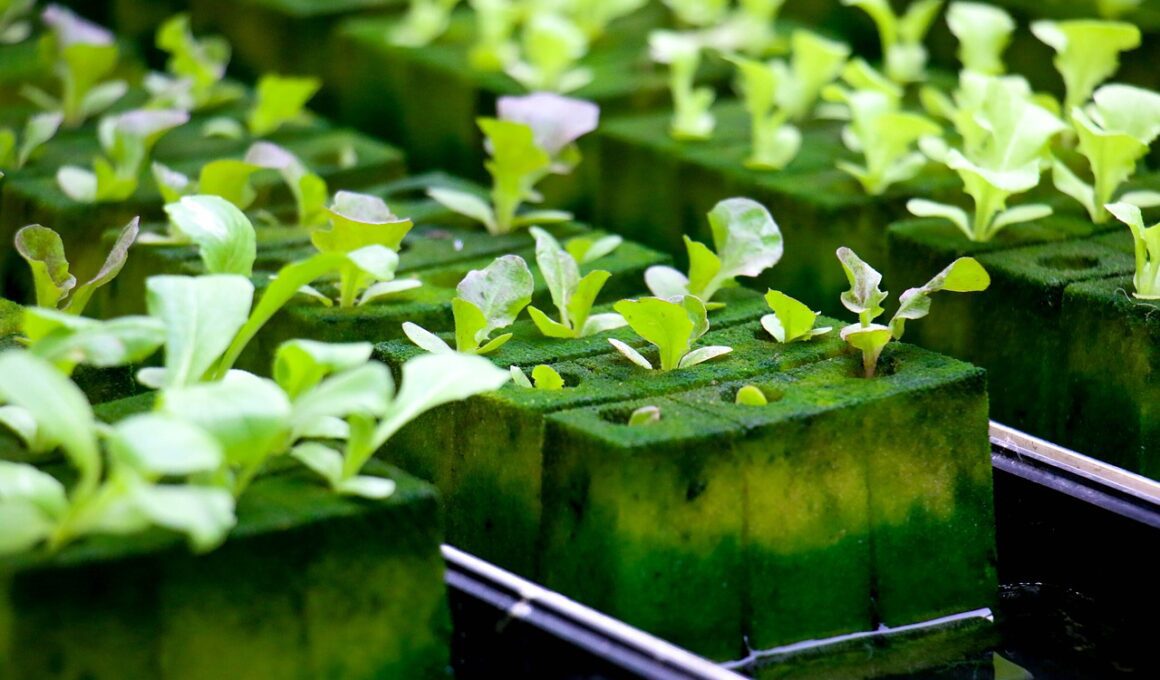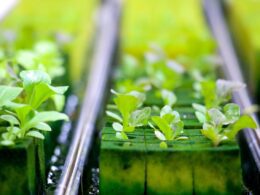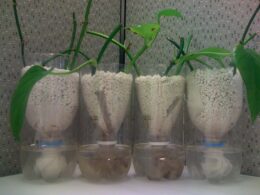Are you interested in growing fresh, nutritious lettuce in the comfort of your own home? Hydroponic lettuce might just be the perfect solution for you. Not only is it easy to grow and maintain, but it also produces a high yield of delicious greens.
But how many times can you harvest hydroponic lettuce? That’s a common question among beginners, and the answer depends on a few factors that you should know about.
In this article, we’ll discuss the factors that affect the number of harvests you can get from your hydroponic lettuce, the growth cycle of the plant, as well as the proper care and maintenance needed to maximize your yield. We’ll also provide tips on how to harvest your lettuce and how to make your hydroponic setup more sustainable.
By the end of this article, you’ll have a better understanding of how to get the most out of your hydroponic lettuce and enjoy a fresh, healthy supply all year round.
Factors that Affect the Number of Harvests
Discovering the key factors that impact how often you can reap fresh, nutrient-rich greens from your hydroponic setup is crucial for maximizing your yield.
Two major factors affecting hydroponic lettuce harvests are light intensity and nutrient concentration. Providing the proper amount of light is essential for photosynthesis, which is the process by which plants create energy. Without enough light, your lettuce plants won’t grow as quickly and won’t produce as much yield. On the other hand, too much light can stress and damage the plants, leading to stunted growth and poor quality harvests.
Another important factor is nutrient concentration. Hydroponic systems rely heavily on nutrient solutions to supply plants with the necessary minerals and nutrients. However, over-supplying nutrients can be just as damaging as under-supplying them. High nutrient concentrations can lead to excessive salt buildup, which can damage the plant’s roots and inhibit growth. It’s important to monitor nutrient levels and adjust accordingly to ensure healthy, productive plants.
In addition to light and nutrient concentration, there are other factors that can impact your hydroponic lettuce harvests. These include temperature, pH balance, and the quality of your water source.
By carefully monitoring and adjusting these factors as needed, you can ensure that your lettuce plants are healthy and productive, which will ultimately lead to more frequent harvests of fresh, delicious greens.
Understanding the Growth Cycle of Hydroponic Lettuce
By understanding the growth cycle of hydroponic lettuce, you can increase the number of harvests and maximize your yield. Hydroponic lettuce grows faster than traditional soil-grown lettuce because it receives all the necessary nutrients and water directly.
The key to achieving multiple harvests is to understand the growth cycle of hydroponic lettuce. The growth cycle can be broken down into three main stages: seedling, vegetative, and maturity.
During the seedling stage, lettuce requires a lot of light to establish its roots and grow its first true leaves. As the plant enters the vegetative stage, it requires more nutrients to support leaf growth. Finally, during the maturity stage, the plant needs less light and nutrients because it is focused on producing a head of lettuce.
By providing the correct lighting requirements and nutrient solutions at each stage, you can ensure that your hydroponic lettuce will grow to its full potential. By understanding the growth cycle of hydroponic lettuce, you can achieve multiple harvests and increase your yield.
The key to success is to provide the correct lighting requirements and nutrient solutions at each stage of the plant’s growth cycle. With proper care and attention, you can enjoy a steady supply of fresh, crisp lettuce throughout the year.
Do Nutrients Need to be Used During Every Hydroponic Lettuce Harvest?
Using nutrients when watering is essential for hydroponic lettuce harvests. Nutrients provide the necessary elements for plant growth, ensuring optimal health and productivity. Each harvest depletes the solution, making it crucial to replenish the nutrients for subsequent crop cycles. Neglecting this could lead to nutrient deficiencies and hinder plant growth. Therefore, consistent use of nutrients during every hydroponic lettuce harvest is vital for achieving healthy and high-yielding crops.
Proper Care and Maintenance of Hydroponic Lettuce
Proper care and maintenance are essential for ensuring the optimal growth and yield of your hydroponic lettuce. One of the most important aspects of care and maintenance is providing the proper nutrient solution. Your hydroponic lettuce needs a balanced mixture of nutrients to grow healthy and strong.
Be sure to regularly monitor the pH level of the nutrient solution, as any fluctuations can have negative effects on your plants.
In addition to providing the proper nutrient solution, lighting requirements must also be met. Hydroponic lettuce requires a minimum of 12 hours of light per day, but up to 16 hours may be necessary for optimal growth. Be sure to provide your plants with a consistent light source, as any interruptions or changes in lighting can cause stress and affect the growth of your lettuce.
Regular maintenance of your hydroponic system is also crucial. Check for any clogs or leaks in the system, and clean it regularly to prevent the buildup of algae or other harmful microorganisms.
By providing the proper nutrients, lighting, and maintenance, you can ensure a healthy and abundant harvest of hydroponic lettuce.
Harvesting Hydroponic Lettuce
When it comes to harvesting hydroponic lettuce, timing and frequency are crucial. You need to know the right time to harvest and how often you can do it without damaging the plant.
Cutting techniques are also important as you want to ensure a clean cut that promotes regrowth.
Finally, how you handle and store the lettuce after harvest will determine how long it stays fresh.
Timing and Frequency of Harvests
Get ready to enjoy a steady supply of fresh and delicious greens by mastering the perfect timing and frequency for harvesting your hydroponic lettuce. Here are a few tips to help you achieve optimal results:
-
Start by monitoring the plant’s growth and maturity. You can do this by checking the leaves and examining the size and shape of the head. Once the lettuce has reached maturity, it’s time to harvest. This usually takes around 30-45 days from the time of planting.
-
When harvesting, it’s best to cut the plant at the base of the stem. Be sure to use a sharp knife or scissors to prevent damage to the plant.
-
After harvesting, you can expect the lettuce to regrow, and you can repeat the process up to three times, depending on the conditions and nutrient management of your hydroponic system.
By following these simple guidelines, you can ensure a steady supply of fresh and nutritious lettuce from your hydroponic garden. Remember to monitor the plants closely and adjust the timing and frequency of your harvests as needed to achieve the best results.
Techniques for Cutting Lettuce
To easily cut your hydroponic lettuce, all you need is a sharp knife or scissors and a steady hand. The key is to use pruning methods that promote healthy growth and prevent damage to the plant. When selecting a knife, choose one with a thin, sharp blade that can easily slice through the lettuce without crushing or tearing it.
To start, make a clean cut just above the first set of leaves. This will encourage the plant to grow new leaves and create a fuller head of lettuce. For leafy lettuce varieties, you can also use the ‘cut-and-come-again’ method, where you snip off the outer leaves as needed and allow the inner leaves to continue growing.
Just be sure to make the cuts at a slight angle to prevent water from pooling on the cut surface and potentially promoting disease. With these simple techniques, you can ensure a bountiful and healthy harvest of hydroponic lettuce.
Handling and Storage of Harvested Lettuce
Properly handling and storing your harvested lettuce is crucial for preserving its crispness and freshness, ensuring a delicious and satisfying meal every time.
After cutting the lettuce, rinse it thoroughly with cold water to remove any dirt or debris. Then, gently pat dry the leaves with a paper towel or cloth to remove excess moisture.
To differentiate freshness, look for crisp, bright green leaves that are not wilted or slimy.
You can prolong the shelf life of your lettuce by storing it in a plastic bag or airtight container in the refrigerator. Be sure to remove any excess air from the bag or container to prevent wilting.
By taking these simple steps, you can enjoy your hydroponic lettuce for several days, giving you plenty of opportunities to savor its delicious taste and nutritional benefits.
Maximizing Yield and Sustainability
By implementing sustainable and efficient practices, you can continually reap the benefits of your hydroponic lettuce crop and optimize your yield. Here are some tips to help you maximize your yield and sustainability:
-
Nutrient Management: Ensure that your hydroponic system has the proper nutrient balance for your lettuce crop. Too much of a certain nutrient can lead to plant damage and decreased yields. Regularly monitor the pH and nutrient levels in your system and adjust accordingly.
-
Lighting Optimization: The right lighting is essential for healthy lettuce growth. LED lights are a popular choice for hydroponic systems, as they’re energy-efficient and can be customized to provide the optimal light spectrum for your crop. Be sure to position your lights at the correct distance from your plants to prevent burning or stunted growth.
-
Harvesting Techniques: To optimize your yield, use a harvesting technique that promotes new growth. Instead of cutting the entire plant at once, selectively harvest the outer leaves and allow the inner leaves to continue growing. This will ensure a longer harvest time and greater overall yield.
By implementing these sustainable and efficient practices, you can optimize your hydroponic lettuce crop and enjoy a continual harvest. Remember to regularly monitor your nutrient levels, use the right lighting, and employ effective harvesting techniques. With these tips, you can enjoy fresh, healthy lettuce for months on end.
Frequently Asked Questions
What are the best types of hydroponic lettuce for multiple harvests?
When it comes to hydroponic lettuce, there are certain types that are better suited for multiple harvests. Some of the best options include looseleaf, butterhead, and romaine lettuce.
These varieties can be harvested using a variety of techniques, such as cutting the leaves off at the base or harvesting the entire head. To ensure that your lettuce continues to produce quality yields, it’s important to make sure that they are receiving the proper nutrient requirements.
This means regularly checking the pH levels of your water, as well as making sure that your plants are getting the right balance of nutrients. With the right harvesting techniques and nutrient requirements, you can enjoy multiple harvests of delicious hydroponic lettuce.
Is it possible to grow hydroponic lettuce all year round?
You can definitely grow hydroponic lettuce all year round, but there are some seasonal limitations to keep in mind. Depending on the type of lettuce you choose, you may be able to have a continuous harvest throughout the year.
However, some varieties may not do well in extreme heat or cold, so you may need to adjust your growing conditions accordingly. It’s important to keep a close eye on your plants and make any necessary adjustments to ensure a healthy and productive harvest.
With proper care and attention, you can enjoy fresh, delicious hydroponic lettuce all year round.
How do you prevent pests and diseases in hydroponic lettuce?
To prevent pests and diseases in your hydroponic lettuce, consider companion planting. Some plants, like marigolds, can act as natural pest deterrents.
Additionally, there are various natural remedies you can use to combat common issues, such as spraying a mixture of water and neem oil to prevent fungal growth.
It’s important to monitor your plants regularly and address any issues promptly to prevent them from spreading. By incorporating these practices, you can help ensure a healthy and abundant harvest of hydroponic lettuce.
Can you reuse the nutrient solution in hydroponic lettuce systems?
To make the most of your hydroponic lettuce system, it’s important to recycle your nutrient solution. This involves regularly monitoring the pH levels to ensure that the solution remains at an optimal level for plant growth.
By doing so, you’ll not only save money by reusing your nutrient solution, but you’ll also help prevent potential nutrient imbalances that can lead to plant disease.
So, if you’re looking to get the most out of your hydroponic lettuce system, be sure to prioritize nutrient solution recycling and pH management to ensure the health and longevity of your plants.
What are some common mistakes to avoid when growing hydroponic lettuce?
When growing hydroponic lettuce, common mistakes can lead to nutrient imbalances that can harm your plants. One of the most common mistakes is not properly monitoring the pH level of your nutrient solution, which can cause nutrient deficiencies or toxicities.
Another mistake is overfeeding your plants, which can lead to nutrient burn. It’s important to follow the recommended nutrient ratios and feeding schedule for your specific crop to avoid these issues.
Additionally, not providing enough oxygen to your plants’ roots can cause root rot and other problems. Properly aerating your nutrient solution and ensuring adequate circulation can help prevent this.
By avoiding these common mistakes, you can ensure a healthy and plentiful harvest of hydroponic lettuce.
Conclusion
So, how many times can you harvest hydroponic lettuce? The answer depends on several factors that affect the growth and productivity of the plant.
With proper care and attention, you can expect to harvest your hydroponic lettuce multiple times, giving you a sustainable and continuous supply of fresh greens.
To maximize your yield and ensure the sustainability of your hydroponic lettuce, it’s important to understand the growth cycle of the plant, as well as its unique needs and requirements. By providing the right conditions, nutrients, and care, you can enjoy a bountiful harvest of hydroponic lettuce that can last for several weeks or even months.
So go ahead and start your hydroponic lettuce garden today, and enjoy the fresh, healthy, and delicious benefits of this innovative and sustainable growing method.









